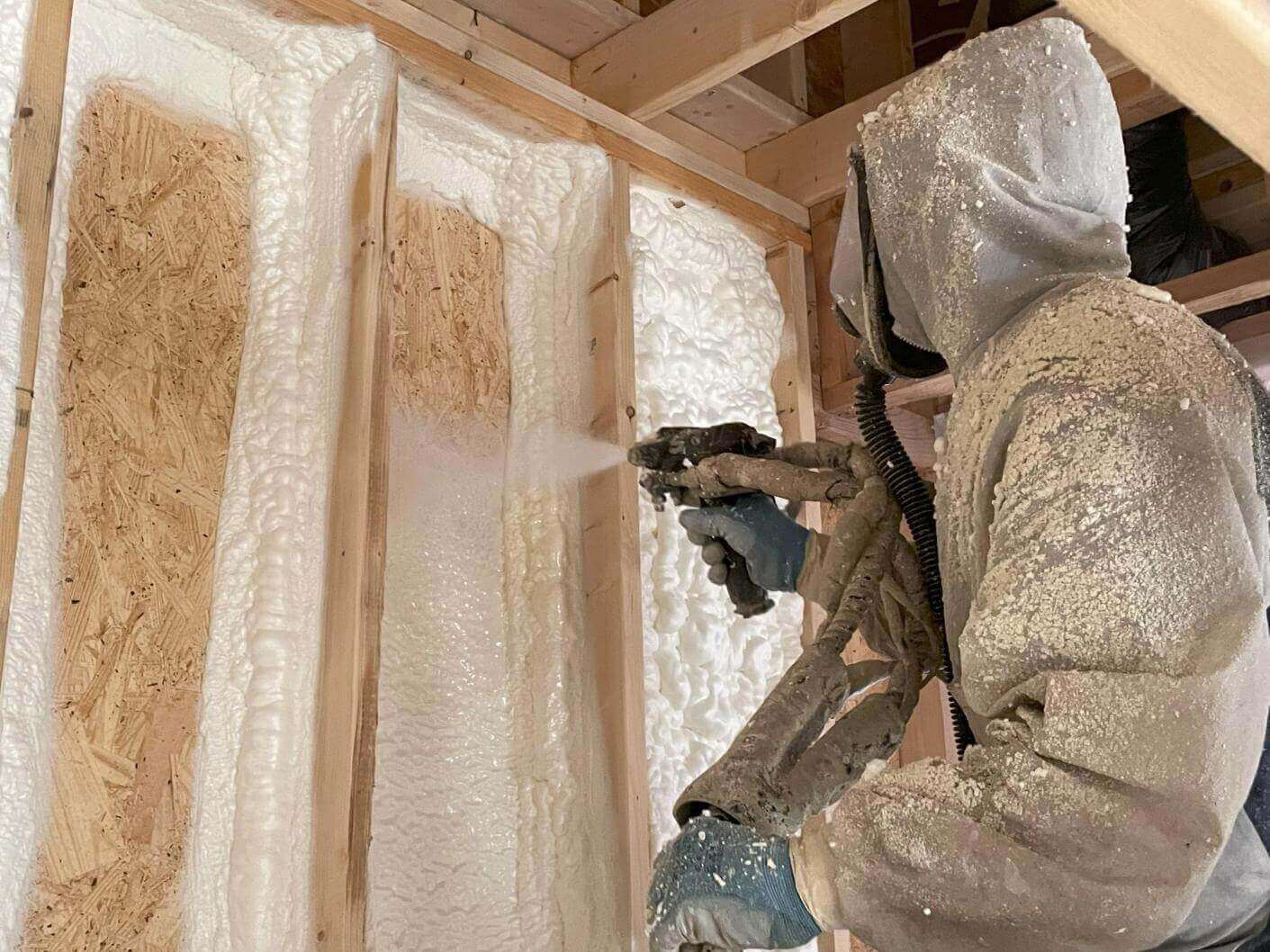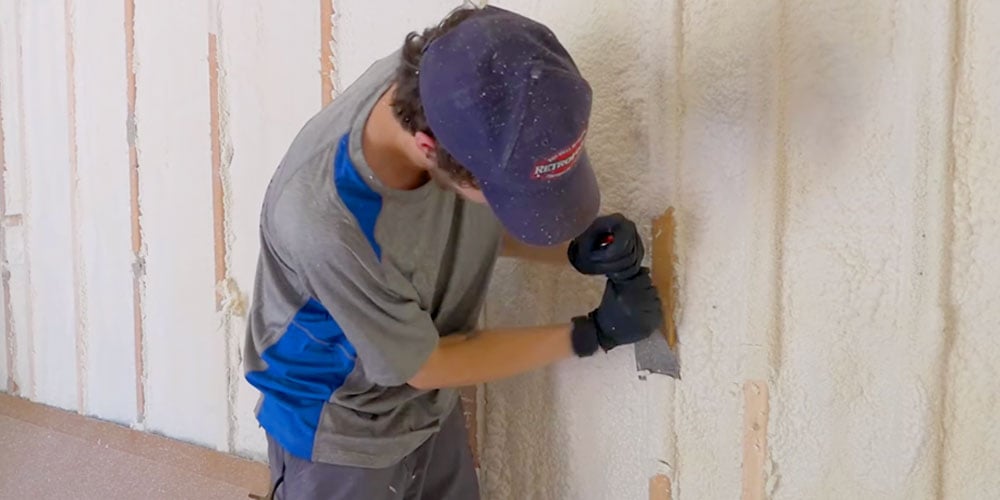Picking the Right Sort Of Spray Foam for Your Insulation Demands
Picking the Right Sort Of Spray Foam for Your Insulation Demands
Blog Article
Spray Foam: The Ultimate Option for Air Sealing and Insulation
Spray foam insulation has arised as a leading solution for effective air sealing and thermal insulation, offering an one-of-a-kind mix of homes that set it apart from typical methods. Its capacity to expand and fill spaces makes it particularly efficient in preventing air leakage, which can considerably influence power efficiency. Nevertheless, comprehending the full range of its advantages, installment processes, and comparisons with other insulation kinds is critical for making notified decisions. As we check out these elements, the effects for both brand-new building and constructions and retrofits end up being progressively significant. What aspects should affect your selection?
What Is Spray Foam?
Spray foam is a functional insulation material that combines the concepts of air sealing and thermal resistance to enhance energy performance in structures. Made up largely of polyurethane or other similar substances, spray foam is applied as a liquid that expands upon call with surface areas, producing a strong, continual layer of insulation. This distinct property permits it to fill up voids, splits, and voids that traditional insulation products might forget, providing a remarkable air seal.
There are two primary kinds of spray foam: open-cell and closed-cell. Open-cell spray foam is lighter and much more flexible, supplying exceptional noise absorption and a reduced R-value per inch - Spray Foam. In contrast, closed-cell spray foam is denser, providing a greater R-value, moisture resistance, and added structural integrity to developing parts
The application procedure normally involves customized equipment, ensuring a smooth application that sticks to various substratums, including concrete, metal, and wood. This versatility makes spray foam suitable for both new constructions and retrofitting existing frameworks. Its capacity to create an impermeable barrier dramatically adds to reducing energy intake and improving indoor air high quality, therefore making it a recommended choice among home owners and building contractors alike.
Advantages of Spray Foam Insulation
Among the most significant benefits of spray foam insulation is its outstanding capability to develop a continual air obstacle, which efficiently reduces energy loss. Unlike traditional insulation materials, spray foam expands to fill up fractures and gaps, making sure that air leak is drastically decreased. This particular not only improves energy performance however also brings about decrease energy costs gradually.
Additionally, spray foam insulation supplies exceptional thermal resistance, adding to an extra stable indoor atmosphere. Its high R-value per inch permits efficient insulation in constrained rooms, making it ideal for attic rooms, walls, and crawl spaces. Additionally, the moisture-resistant residential or commercial properties of spray foam help protect against mold and mildew and mold growth, promoting much healthier living problems.
Another crucial advantage of spray foam insulation is its sound-dampening top qualities (Spray Foam). It successfully decreases sound transmission between spaces, creating a quieter and more comfortable home atmosphere. The longevity of spray foam likewise stands out, as it does not droop or work out gradually, keeping its efficiency throughout its lifespan
Just How Spray Foam Works
Recognizing how spray foam insulation functions is important for valuing its effectiveness in air securing and thermal resistance. Spray foam insulation is composed of two key components: isocyanate and polyol resin. When these parts are mixed, they undergo a chain reaction that causes the product to increase rapidly, producing a thick foam that fills gaps, fractures, and dental caries.
As the foam broadens, it adheres to surfaces, forming an airtight seal that dramatically reduces air infiltration. This particular makes spray foam insulation very reliable at avoiding drafts and wetness infiltration, which can cause energy loss and damage in time. Furthermore, the closed-cell version of spray foam supplies exceptional thermal resistance due to its inflexible structure, successfully lessening warmth transfer.
The distinct residential properties of spray foam permit it to satisfy uneven surface areas, making sure thorough insurance coverage and a seamless barrier. Because of this, spray foam insulation not only improves energy performance however likewise contributes to boosted indoor air quality by reducing the build-up of contaminants and allergens. Ultimately, understanding the mechanics behind spray foam emphasizes its duty as a superior choice for insulation and air securing in both industrial and residential applications.
Installment Refine Summary

Prior to setup, the room must be effectively cleaned and prepped, guaranteeing that surface areas are without dampness, debris, and dust. Due to the fact that contaminants can compromise bond and general performance, this step is vital. Once the area is prepared, the application involves mixing the two components of the spray foam, which broadens upon get in touch with and fills up spaces successfully.
Educated specialists need to perform the installment, making use of customized tools to make certain uniform coverage and optimal density. Safety precautions, consisting of putting on safety gear and making sure appropriate ventilation, are critical throughout this procedure. After application, the foam normally remedies rapidly, forming a solid barrier that improves energy performance.
Contrasting Spray Foam to Standard Insulation
When examining insulation choices, spray foam insulation stands apart in comparison to standard materials such as fiberglass and cellulose. One of the key advantages of spray foam is its superior air securing capabilities. Unlike fiberglass and cellulose, which can enable air infiltration, spray foam increases upon application, filling up spaces and crevices to create an impermeable seal. This leads to boosted power efficiency, as much less heated or cooled down air gets away the home, resulting in reduced utility bills.
Furthermore, spray foam gives a higher R-value per inch than typical insulation types, supplying more reliable thermal resistance in a thinner profile. This particular is particularly valuable in areas with limited cavity depth. In addition, spray foam is resistant to wetness and mold and mildew growth, which can be a substantial worry about cellulose and fiberglass, especially in moist environments.
However, spray foam insulation usually lugs a higher upfront expense than its typical equivalents. Property owners need to consider this first investment against long-lasting energy cost savings and efficiency advantages. Inevitably, while both insulation types serve their purpose, spray foam emerges as a much more try this web-site sophisticated remedy for modern-day insulation demands, specifically in regards to air sealing and thermal efficiency.

Verdict
In recap, spray foam insulation stands for an extremely efficient service for accomplishing optimal air sealing and thermal resistance. Its unique homes, including wetness resistance and sound dampening, make it suitable for numerous applications in both brand-new buildings and retrofitting jobs (Spray Foam). The initial costs might be greater compared to typical insulation materials, the long-lasting benefits, such as substantial energy savings and boosted indoor air quality, warrant the investment and underscore its value in contemporary building practices.
Spray foam insulation has emerged as a leading solution for effective air securing and thermal insulation, using an unique mix of buildings that set it apart from traditional techniques.Spray foam is a versatile insulation material that incorporates the principles of air securing and thermal resistance to enhance power performance this website in buildings.When assessing insulation alternatives, spray foam insulation stands out in comparison to standard products such as fiberglass and cellulose. Eventually, while both insulation kinds offer their function, spray foam arises as a more sophisticated remedy for modern insulation requirements, specifically in terms of air sealing and thermal effectiveness.
In recap, spray foam insulation stands for a highly efficient solution for achieving ideal air securing and thermal resistance.
Report this page